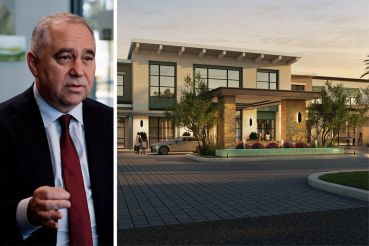Gensler’s Juliette Morgan Leads The Way on Designing for Impact
The head of Gensler’s climate action and sustainability practice wants environmentally-friendly design to become second nature
By Anna Staropoli April 17, 2024 11:53 am
reprints
For Juliette Morgan, a London-based ESG consultancy director and global leader in architecture giant Gensler’s climate action and sustainability practice, this potential for impact ranks as the most rewarding aspect of working in sustainability. In her two years at Gensler, Morgan has made strides toward reducing the impact of buildings by leveraging her own.
She spoke to Commercial Observer on April 9 about designing for impact in the right way; the opportunities for biogenic solutions; and why women seem to occupy many, if not most, of the sector’s leadership roles.
This interview has been edited for length and clarity.
Commercial Observer: Senior sustainability leaders seem to be a given across commercial real estate companies. Given the ubiquity of these roles, what commonalities — if any — have you noticed between the people like yourself who occupy high-level positions in sustainability?
Juliette Morgan: What I see are people driven by a mission, who, quite often, are really motivated to reduce the climate impact of the organization that they’re with. I’ve seen, over the last five years, people coming from various routes to sustainability — architecture and engineering, but also people from public relations backgrounds or corporate social responsibility backgrounds. There hasn’t been a classic route to it. Quite often, that diversity of backgrounds gives different nuances to how people occupy that position.
The other thing I’ve observed is that with sustainability roles comes quite a lot of continuing education. I see a lot of people studying alongside that day job, and I see people with a social conscience who are generally quite helpful. They’re trying to navigate this big climate behemoth with the commercial objectives of whatever it is that they’re dealing with. With that comes a degree of problem solving and compromise. They’re generally working horizontally, not vertically. In Gensler’s case, we have a co-leadership model, so there’s always gender balance, but also background and diversity balance.
I’ve read some articles analyzing how sustainability tends to offer more opportunities for women, who are able to move up the sustainability ladder and occupy high-level positions. Is that a pattern you’ve noticed in real estate?
I did a not-very-scientific piece of research for you today: We’re a member of a group of heads of sustainability in London. There’s 130 people in that Google meet-up group. I counted them all, and it turns out there were 69 women and 53 men, and eight that were unidentifiable from email addresses. I’ve watched women work their way into the boardroom from the sustainability perspective. I’ve definitely observed it, but I don’t think it’s a prerequisite for the job.
Maybe there’s something about that horizontal piece again, and sustainability being systemic. So, classically juggling multiple, different competing interests. Ask any mum — they know how to do that. Maybe there’s a feminine attribute that carries through that’s useful. But I’m sure all the men would hate my answer to that.
You’ve been at Gensler since 2022, and in the past two years the world has experienced more climate disasters. Have your responsibilities changed with the state of the environment?
During those two years, we’ve seen more legislation, global variants of different building standards or lack thereof, like [the Corporate Sustainability Reporting Directive] in Europe and the SEC in North America [the U.S. Securities and Exchange Commission’s new carbon emissions reporting rules for larger public companies]. Some places have no guidance at all. In that time, we’ve seen nature get more prominence and more conversations around resilient design and regenerative design, where maybe conversations are around net zero. The nature of what we as a group deal with hasn’t changed; the urgency and the complexity of it continues.

How do you think the demands of your role and other sustainability leaders’ roles will continue to change as the climate changes, but also as the industry adapts?
If you’re following The Guardian in the U.K., they published an article about how this is the 10th consecutive month of record-breaking hot temperatures, and they can’t tell whether it’s an El Nino effect or if it’s a blip or a long-term climate thing. There’s concern that there’s an acceleration in a way that we haven’t necessarily anticipated. If that’s true, then essentially what I think we’re going to see is an increased focus on adaptive, resilient communities and regenerative and resilient design.
We’ve had conversations around designing for net zero that have been about accounting for carbon. But what that hasn’t been necessarily about is systemically designing for biodiversity and all of our relations with the animal, plant and human communities. What we’ll see is how we can work with nature around resilient design and regenerative environments beyond servicing or prioritizing humans.
Speaking of design, I saw on the Gensler website that your research background is in renewable resources like laminated timber and bamboo. Are those part of what you’re talking about in terms of future adaptations?
They’ve got to be seen in the context of where they’re appropriate to deploy. If you take a hierarchy of decision making, then we should reuse everything we’ve got, use material minimally, use low-carbon-
impact material like net-zero concrete or recycled steel. But where there’s an opportunity to use biogenic material — grown materials — then we should prioritize doing that, because their environmental impact is lower and, in some cases, they can sequester carbon as they go.
There is a role for laminated timber in construction that’s been written about a lot. Laminated bamboo grows three times faster than trees and is a rhizome, so you don’t kill the plant when you harvest it in the way that you do a tree. If it just falls over in the wild, that carbon gets released back to the atmosphere, and it becomes a cycle.
So, using it in construction is actually quite a good way of sequestering that carbon away. There are places where it’s contextual and appropriate to use it, and there are places where it’s less so, but I’ve been interested to see it deployed in airports and car parks, even in Europe. It has a higher silicon content, so it behaves differently in fire and can outperform steel in terms of its strength under compression. Historically, it’s become unpopular because it used to get eaten by insects in tropical climates, so you treat it with borax. There’s an interesting opportunity for it to be used in laminate with timber.
Gensler has just worked on what we call Gensler product standards and cataloged something like 50,000 samples — all of which have to meet a minimum sustainability requirement. That means our teams can confidently use materials. It’s easy to think that the big drivers are concrete, glass and steel, but, when you refurbish buildings over their lifetime, up to 45 percent of carbon emissions can be in that reuse of furniture. So, focusing on interior finishes is as important.
You’re based in London, but Gensler is a global firm. What differences have you noticed specifically between Europe and the U.S. in terms of sustainability approaches?
Europe is quite culturally aligned to legislation and regulation. We like being compliant and socially aligned to a lot more public transit. There’s been even more focus on nature and biodiversity. Water pollution reporting generally is easier to accept. Within Europe, there are multiple different building regulation standards, so you’d be designing to a different standard in London than to Paris, Sweden or Germany.
We’ve even seen European legislation on how to speak about environmental matters from greenwashing and greenhushing and the words “sustainable” and “eco.”
North America has been arguably more impacted by environmental outcomes. What do I mean by that? Wildfires, floods, storms. The SEC has been slower, and we’ve seen more pushback on the term “ESG” or reporting. The appetite is absolutely there in North America, as is the investment in technological solutions. But, in the cultural approach, there’s been some differences.
How does your approach to sustainable design change depending on the place?
The approach is always to retain, reuse and prioritize green materials, but then it has to be context specific. So, daylight, sunlight, climate, client. The approach is the same, and then it’s nuanced to be correct for the location, client, the occupier and the financier.


